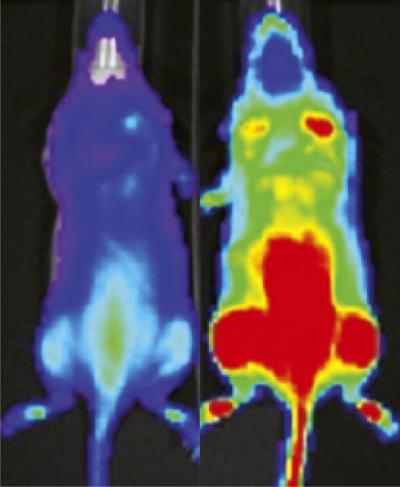A unique new probe based on luciferase, the enzyme that gives fireflies their glow, enables researchers to monitor hydrogen peroxide levels in mice and thereby track the progression of infectious diseases or cancerous tumors without harming the animals or even having to shave their fur. Developed by researchers with the Lawrence Berkeley National Laboratory (Berkeley Lab) and the University of California (UC) Berkeley, this new bioluminescent probe has already provided the first direct experimental evidence that hydrogen peroxide is continuously made even in a healthy animal.
"We are reporting the design, synthesis, and in vivo applications of Peroxy Caged Luciferin-1 (PCL-1), a chemoselective bioluminescent probe for the real-time detection of hydrogen peroxide within living animals," says Christopher Chang, a chemist who holds appointments with Berkeley Lab's Chemical Sciences Division and UC Berkeley's Chemistry Department, as well as the Howard Hughes Medical Institute.
Chang is the corresponding author of a paper in the Proceedings of the National Academy of Science (PNAS) that describes this research. The paper is titled "In vivo imaging of hydrogen peroxide production in a murine tumor model with a chemoselective bioluminescent reporter." Co-authoring with Chang were Genevieve Van de Bittner, Elena Dubikovskaya and Carolyn Bertozzi.
The PCL-1 probe consists of a light-emitting luciferin molecule enclosed inside a molecular cage of boronic acid. The boronic acid selectively reacts with hydrogen peroxide molecules to release the luciferin, triggering a bioluminescent response in the presence of firefly luciferase. For their studies, Chang and his co-authors worked with transgenic mice that carried the firefly luciferase gene.
"The high sensitivity and selectivity of the PCL-1 probe for hydrogen peroxide, combined with the favorable properties of bioluminescence for in vivo imaging, afford a unique technology for monitoring physiologicalfluctuations in hydrogen peroxide levels in real-time," Chang says. "This offers opportunities to dissect the disparate contributions of hydrogen peroxide to health, aging and disease."

Bioluminescent signals from firefly luciferase lights up a mouse 30 minutes after injection with PCL-1, a probe that can be used to monitor hydrogen peroxides without harming the animal.
(Photo Credit: Photo from Christopher Chang group)
Hydrogen peroxide is nature's disinfectant. Cells produce this small but highly reactive molecule to kill invading pathogens. It also plays a critical role in cellular signaling that is essential to the growth, development and physical well-being of humans and other organisms. However, over-production of hydrogen peroxide in cells is the mark of oxidative stress and inflammation, and has been linked to the onset and advancement of cancer and diabetes, and numerous cardiovascular and neurodegenerative diseases.
Chang and his group have shown that hydrogen peroxide can serve as a highly effective signaling agent for in vivo imaging. To this end, they've developed a series of hydrogen peroxide fluorescent tags for tracking small-molecule oxygen metabolites in living cells, tissue and organisms. With their new PCL-1 probe, they were able to study mice with prostate cancers and monitor fluctuations in the hydrogen peroxide generated by cancerous cells based on the amount of light emitted by the probe.
"The PCL-1 probe enables us to study the chemistry in living animals as cancers and other diseases progress," Chang says. "We can use the probe to look at the same mouse over time to see how see how therapeutics and other treatments affect its physiology, without having to do biopsies or sacrifice the animal. This is a significant advance over previous hydrogen peroxide probes."
In addition to doing no harm to the animal, Chang and his group wanted a probe that could simultaneously detect hydrogen peroxide signals from multiple regions or the entire organism. They also wanted a probe that could detect intracellular signals, and preferred not having to remove fur or skin to detect a signal from a specific tissue of interest. They elected to pursue bioluminescence because of its favorable properties for in vivo imaging.
"The fact that in nature fireflies use the luciferin enzyme to communicate by light inspired us to adapt this same strategy for pre-clinical diagnostics," Chang says. "Bioluminescence from the catalytic transformation of firefly luciferin by the firefly luciferase enzyme exhibits a high efficiency for photon production and a 612 nanometer emission frequency that provides a detectable bioluminescent signal in all organs of a mouse. The PCL-1 probe is small enough to travel through a mouse's body andits redshifted luminescent reaction with luciferase allows for deep tissue signal penetration with an optical readout."
Chang and his colleagues are now working to improve the sensitivity of the PCL-1 probe. They would also like to refine their methodology to be able to simultaneously examine multiple biomarkers.